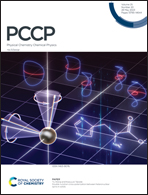Vibrational properties of metastable orthorhombic Bi2Se3†
Abstract
Chalcogenide materials are being considered as some of the most promising systems for energy harvesting and energy conversion. Among them, the orthorhombic family of compounds X2Y3 (with X = Bi, Sb and Y = S, Se) has attracted special attention due to its interesting atomic structure and thermoelectric and optical properties. While Bi2S3 and Sb2Se3 have already been applied to solar cells, practical application of the new metastable Bi2Se3 is still a challenge due to the lack of data and knowledge on its properties. Here, the vibrational and structural properties of the orthorhombic metastable phase of Bi2Se3 are investigated by using Raman spectroscopy and ab initio calculations. We perform Raman spectroscopy measurements along with in situ thermal treatment on samples grown by electrochemical deposition. We show that by increasing the temperature an improved crystallization occurs in the orthorhombic structure, followed by recrystallization to the usual rhombohedral phase. Our results point out specific Raman modes of the orthorhombic phase. First principles computational results based on the density functional theory support the experimental data and describe three singlet Raman active vibrational modes, such as B(2)3g, B(2)2g and A(6)g.



 Please wait while we load your content...
Please wait while we load your content...